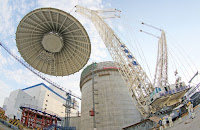Westinghouse is poised to start up its first AP1000 nuclear reactors in China, fighting on in a troubled market.
By late this year or early in 2018, two nuclear reactors could start operating in China—an event that might be a lifesaver for the units’ crippled builder and designer, Westinghouse Electric Co., and for the technology they represent. Both Westinghouse and its prized AP1000 reactor design have suffered a series of humbling setbacks this year.
The AP1000 is arguably the world’s most advanced commercial reactor. It is designed to passively cool itself during an accidental shutdown, theoretically avoiding accidents like those at Ukraine’s Chernobyl power plant and Japan’s Fukushima Daiichi. And for over a decade it has been the presumed successor to China’s mainstay reactors, which employ a 1970s-era French design.
Yet after more than three decades of engineering, regulatory reviews, salesmanship, and construction, the AP1000 has yielded zero electricity and plenty of trouble. Delays and cost overruns at the four reactors under construction in China and another four in the United States drove Westinghouse into bankruptcy this March. And in July South Carolina utilities abandoned their pair of partially built AP1000s—on which they and Westinghouse have spent US $9 billion.
But the Chinese reactors, at the Haiyang Nuclear Power Plant in Shandong and at the Sanmen plant in Zhejiang, could press the reset button for the AP1000 and Westinghouse. And China is where success really matters most because it is the only country building reactors by the dozen.
The question, say experts, is what share the AP1000 can capture of a Chinese reactor market that has taken a downturn since the Fukushima accident and may slow even further. Government plans to tie nuclear power rates to wholesale prices for coal-fired power will “definitely mean a slowdown of nuclear power construction down the road,” says Henry Chan, an Asian geopolitics expert at the National University of Singapore who tracks China’s nuclear energy sector.
The AP1000’s ascent in China began in 2004 when the government launched a rigorous two-year evaluation aimed at selecting an advanced Western reactor design that would underpin its future nuclear sector. The Westinghouse reactor beat out the latest French-German EPR and Russian VVER designs, thanks to its promised blend of safety, affordability via modular construction, and the company’s willingness to progressively transfer ownership of the intellectual property to China.
Read more at A Bittersweet Milestone for the World’s Safest Nuclear Reactors

No comments:
Post a Comment